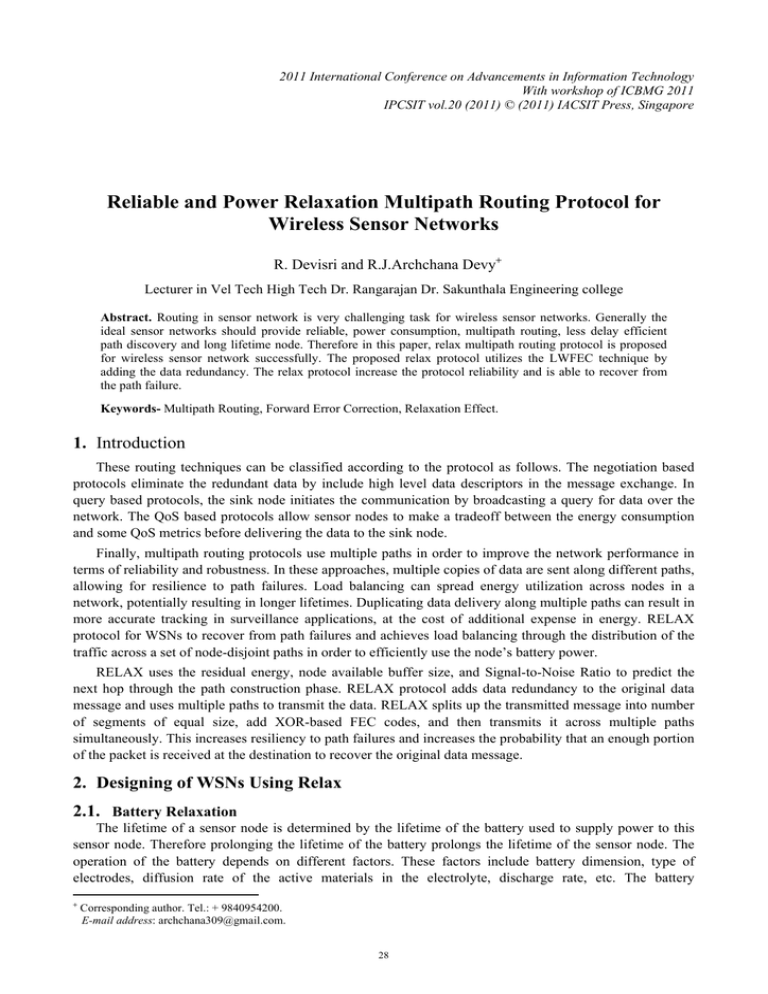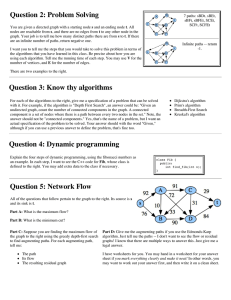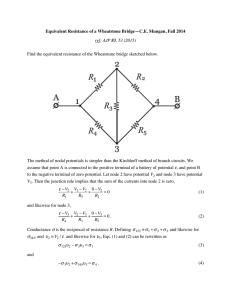Document 13134569
advertisement

2011 International Conference on Advancements in Information Technology
With workshop of ICBMG 2011
IPCSIT vol.20 (2011) © (2011) IACSIT Press, Singapore
Reliable and Power Relaxation Multipath Routing Protocol for
Wireless Sensor Networks
R. Devisri and R.J.Archchana Devy+
Lecturer in Vel Tech High Tech Dr. Rangarajan Dr. Sakunthala Engineering college
Abstract. Routing in sensor network is very challenging task for wireless sensor networks. Generally the
ideal sensor networks should provide reliable, power consumption, multipath routing, less delay efficient
path discovery and long lifetime node. Therefore in this paper, relax multipath routing protocol is proposed
for wireless sensor network successfully. The proposed relax protocol utilizes the LWFEC technique by
adding the data redundancy. The relax protocol increase the protocol reliability and is able to recover from
the path failure.
Keywords- Multipath Routing, Forward Error Correction, Relaxation Effect.
1. Introduction
These routing techniques can be classified according to the protocol as follows. The negotiation based
protocols eliminate the redundant data by include high level data descriptors in the message exchange. In
query based protocols, the sink node initiates the communication by broadcasting a query for data over the
network. The QoS based protocols allow sensor nodes to make a tradeoff between the energy consumption
and some QoS metrics before delivering the data to the sink node.
Finally, multipath routing protocols use multiple paths in order to improve the network performance in
terms of reliability and robustness. In these approaches, multiple copies of data are sent along different paths,
allowing for resilience to path failures. Load balancing can spread energy utilization across nodes in a
network, potentially resulting in longer lifetimes. Duplicating data delivery along multiple paths can result in
more accurate tracking in surveillance applications, at the cost of additional expense in energy. RELAX
protocol for WSNs to recover from path failures and achieves load balancing through the distribution of the
traffic across a set of node-disjoint paths in order to efficiently use the node’s battery power.
RELAX uses the residual energy, node available buffer size, and Signal-to-Noise Ratio to predict the
next hop through the path construction phase. RELAX protocol adds data redundancy to the original data
message and uses multiple paths to transmit the data. RELAX splits up the transmitted message into number
of segments of equal size, add XOR-based FEC codes, and then transmits it across multiple paths
simultaneously. This increases resiliency to path failures and increases the probability that an enough portion
of the packet is received at the destination to recover the original data message.
2. Designing of WSNs Using Relax
2.1. Battery Relaxation
The lifetime of a sensor node is determined by the lifetime of the battery used to supply power to this
sensor node. Therefore prolonging the lifetime of the battery prolongs the lifetime of the sensor node. The
operation of the battery depends on different factors. These factors include battery dimension, type of
electrodes, diffusion rate of the active materials in the electrolyte, discharge rate, etc. The battery
+
Corresponding author. Tel.: + 9840954200.
E-mail address: archchana309@gmail.com.
28
performance with regard to discharge pattern depends on two effects: i) the capacity effect which depends on
the battery actual capacity and the discharge rate; ii) the recovery effect due to the battery recovery during
idle periods.
The battery relaxation periods can be used to mitigate the effect of high discharge rates on the battery
lifetime. If the current drawn from a battery is reduced or completely cut-off, the diffusion and transport of
active materials catches up with the depletion caused by the discharge. This phenomenon is called the
relaxation effect, and enables the battery to recover a portion of its lost capacity. We try to utilize this effect
in prolonging the sensor network lifetime through prolonging the battery lifetime. We assume that each
sensor node in the network is powered by two batteries, where each battery supplies power to the sensor
node for a certain amount of time. Operating the sensor node this way gives the battery a chance to recover a
portion of its lost power during the rest periods, which significantly increases the battery lifetime, and hence
increasing the lifetime of the whole sensor network.
2.2. Link Cost Function
The link cost function is used by the node to select the next hop during the path discovery phase. Let Nx
be the set of neighbors of node x. Then our cost function includes an energy factor, available buffer factor,
and interference factor with appropriate weights (á, â, and ã).
Next hop = max yåNx {á E, y + â B, y + ã I, xy},
Where, E-Eresd, y is the current residual energy of node y, where y å Nx, B-buffer, y is the available
buffer size of node y, and I-interference, xy is the SNR for the link between nodes x and y. The residual
energy of node y is considered but not node x, because node y consumes energy for data reception and
transmission if it is selected as a next hop for node x. We do not consider node x, because whatever node y is,
node x still needs to spend the same amount of energy on data transmission. The total cost for a path P
consists of a set of K nodes is the sum of the individual link costs l(xy)i, i å K along the path refer [4]&[5].
2.3. Paths Discovery Phase
The sink node starts the multiple paths discovery phase to create a set of neighbors that able to forward
data towards the sink from the source node. Fig 1.1 shows the timing diagram of path discovery .The
constructed multipaths are node-disjoint paths. In multipath routing, node-disjoint paths are usually preferred
because they utilize the most available network resources, and hence are the most fault-tolerant. If an
intermediate node in a set of node-disjoint paths fails, only the path containing that node is
Fig1.1: Timing diagram
affected, so there is a minimum impact to the diversity of the routes. The path discovery procedure is
executed according to the following phases:
2.3.1. Initialization phase
Fig 1.2 shows Each sensor node broadcast a HELLO WORLD message to its neighbours in order to
have enough information about which of its neighbours can provide it with the highest quality data. Each
sensor node maintains and updates its neighbouring table during this phase. The neighbouring table contains
information about the list of neighboring nodes of the sensor node. The link quality field is expressed in
29
terms of signal-to-noise ratio for the link between the source node and its neighbour. Hop count gives the
distance in hops for the message from its originator.
2.3.2. Primary Path Discovery Phase
After initialization phase, each sensor node has enough information to compute the cost function for the
links to its neighbours. Then, the sink node locally computes its preferred next hop node using the link cost
function, and sends out a RREQ message to its most preferred next hop. Similarly, through the link cost
function, the preferred next hop node of the sink computes locally its most preferred next hop in the direction
of the source node, and sends out a RREQ message to its next hop, the operation continues until source node.
Fig1.2: Broadcast a HELLO packet to the neighbours
2.3.3. Alternative Paths Discovery Phase
For thesecond alternate path, the sink sends alternate path RREQ message to its next most preferred
neighbour. To avoid having paths with shared nodes, we limit each node to accept only one RREQ message.
For those nodes that receive more than one RREQ message, only accept the first RREQ message and reject
the remaining messages. Node has been included in the primary path, then node is included in the alternate
path and then those nodes are communicating with an INUSE message
2.4. Route Refreshing
To keep multiple paths alive, the source node periodically floods a KEEP ALIVE message over multiple
paths to keep them alive. The frequency of the KEEP ALIVE message determines how quickly the routing
protocol recovers from failures on the primary path.
2.5. Traffic allocation and Data Transmission
After multiple paths have been discovered, the source node begins to transmit data messages to the sink.
To deliver data to the sink node, we use a subset of the available paths to transfer the message in order to
distribute the load over the nodes, and to avoid the fast battery drains because of the extensive use of the
same path to carry a long message for long time. We split up the message into small parts, add error
correction codes, and then transmit it across multiple paths simultaneously to increase resiliency to path
failures and ensure that an essential portion of the packet is received at the destination without incurring
excessive delay through data retransmission. At the sink node, the parts are collected, reassembled, and the
original message is recovered.
2.6. Paths Selection
After the completion of paths discovery phase and the paths have been constructed , we need to select a
set of paths from the N available paths to transfer the traffic from the source to the destination with a desired
bound of data delivery given by á shown in fig 1.3.
30
Fig1.3: Path selection from sink node to destination
To find the number of required paths, rate pi (i=1, 2, .. n) that corresponds to the probability of
successfully delivering a message to the destination. As the paths are arranged according to their quality
during the path construction phase, the first k paths out of the N available paths(refer to [4]) are selected to
be used to transfer the gathered data.
2.7. Message Segmentation and FEC Codes Generation
Type
Reserved
Hop count
Broadcast ID
Destination IP Address
Destination Sequence Number
Source IP Address
Source Sequence Number
Request Time
Fig1.4:Structure of a RREQpacket
The data message(Fig 1.4 shows structure of a RREQ packet) is split up into k equal sized segments (S0,
S1, S2, … Sk-1), and over head part of M+1, error correction codes (C0 C1, C2, C3, … CM) of same size as
the data segment are added to the original message. The data segments and error correction codes are of the
same size and should be multiple of 8. Correction codes are calculated as a function of the information bits to
provide redundant information. We use an XOR-based coding algorithm. This algorithm does not require
high computation power or high storage space.
3. Performnace Evaluation
Simulation environment consists of a field of 500m x 500m containing 300 sensor nodes randomly
deployed. All nodes are identical with a radio transmission range set to 25m.
3.1. Network Size
The packets arrival rate is at 50 packets per sec, and change the number of nodes in the field from 50 to
300 nodes in step of 50 nodes each time
3.2. Energy Consumption
As the network size increases RELAX becomes more stable than other protocols. RELAX maintains low
energy consumption even at higher traffic rates. Such results demonstrate that our protocol is stable in terms
of energy consumption and is slightly affected by the increase in the traffic rate. When compared to directed
diffusion, RELAX improves energy savings by 9% to 37%.
3.3. Delivery Ratio
31
As the network size gets large, there are more available nodes, and hence more routes to forward data,
resulting in increasing the delivery ratio. Because multiple paths are used at the same time to transfer data
packets. RELAX employs an error correction scheme which contributes in increasing the delivery ratio in the
case of path failures by reconstructing the original message using the generated XOR-codes.
Delay RELAX protocol outperforms other protocols by having the shortest delay. This better
performance is contributed by routing data across multiple paths and by the bulletin error correction scheme,
which increases the resiliency of the protocol to path failures and increases the probability that an enough
portion of the packet is received at the destination to recover the original data packet without incurring
excessive delay through data retransmissions. Node Lifetime RELAX protocol outperforms other protocols
and maintains long lifetime durations. This is because of the utilization of the relaxation effect of the
batteries.
4. References
[1] K. Akkaya, M. Younis, “A Survey on Routing for Wireless Sensor Networks”, Journal of Ad Hoc
Networks, Vol. 3, Pages: 325-349, 2005.
[2] A. Martirosyan, A. Boukerche, R. W. N. Pazzi: A Taxonomy of Cluster- Based Routing Protocols for
Wireless Sensor Networks. ISPAN 2008: 247-253
[3] A. Martirosyan, A. Boukerche, R. W. N. Pazzi: Energy-aware and quality of service-based routing in
wireless sensor networks and vehicular ad hoc networks. Annales des Télécommunications 63(11-12):
669-681 (2008)
[4] J. Tsai, T. Moors, “A Review of Multipath Routing Protocols: From Wireless Ad Hoc to Mesh
Networks”, In Proc. of ACoRN Early Career Researcher Workshop on Wireless Multihop Networking,
Jul. 17-18, 2006
[5] D. Ganesan, R. Govindan, S. Shenker, D. Estrin, “Highly-resilient, energy-efficient multipath routing in
wireless sensor networks”, ACM SIGMOBILE Mobile Comp. and Comm. Review, 5(4):11–25, 2001.
32



